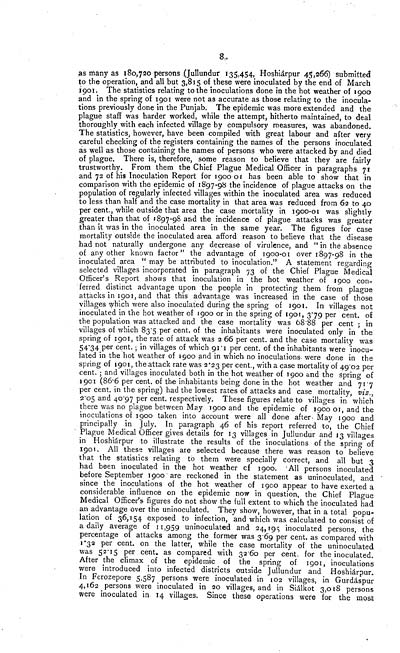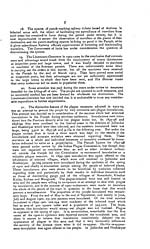Medicine - Disease > Report on plague and inoculation in the Punjab from October 1st ... to September 30th..., being the ... season of plague in the province
(20) Page 8
Download files
Individual page:
Thumbnail gallery: Grid view | List view

8.
as many as 180,720 persons .(Jullundur 135,454, Hoshirpur 45,266) submitted
to the operation, and all but 3,815 of these were inoculated by the end of March
1901. The statistics relating to the inoculations done in the hot weather of 1900
and in the spring of 1901 were not as accurate as those relating to the inocula-
tions previously done in the Punjab. The epidemic was more extended and the
plague staff was harder worked, while the attempt, hitherto maintained, to deal
thoroughly with each infected village by compulsory measures, was abandoned.
The statistics, however, have been compiled with great labour and after very
careful checking of the registers containing the names of the persons inoculated
as well as those containing the names of persons who were attacked by and died
of plague. There is, therefore, some reason to believe that they are fairly
trustworthy. From them the Chief Plague Medical Officer in paragraphs 71
and 72 of his Inoculation Report for 1900 01 has been able to show that in
comparison with the epidemic of 1897-98 the incidence of plague attacks on the
population of regularly infected villages within the inoculated area was reduced
to less than half and the case mortality in that area was reduced from 62 to 40
per cent., while outside that area the case mortality in 1900-01 was slightly
greater than that of \ill\897-98 and the incidence of plague attacks was greater
than it was in the inoculated area in the same year. The figures for case
mortality outside the inoculated area afford reason to believe that the disease
had not naturally undergone any decrease of virulence, and " in the absence
of any other known factor" the advantage of 1900-01 over 1897-98 in the
inoculated area " may be attributed to inoculation.3' A statement regarding
selected villages incorporated in paragraph 73 of the Chief Plague Medical
Officer's Report shows that inoculation in the hot weather of 1900 con-
ferred distinct advantage upon the people in protecting them from plague
attacks in 1901, and that this advantage was increased in the case of those
villages which were also inoculated during the spring of 1901. In villages not
inoculated in the hot weather of 1900 or in the spring of 1901, 379 per cent, of
the population was attacked and the case mortality was 68.88 per cent ; in
villages of which 83.5 per cent, of the inhabitants were inoculated only in the
spring of 1901, the rate of attack was 2 66 per cent, and the case mortality was
54.34 per cent. ; in villages of which 91.1 per cent, of the inhabitants were inocu-
lated in the hot weather of 1900 and in which no inoculations were done in the
spring of 1901, the attack rate was 2.23 per cent., with a case mortality of 4902 per
cent. ; and villages inoculated both in the hot weather of 1900 and the spring of
1901 (86.6 per cent, of the inhabitants being done in the hot weather and 71.7
per cent, in the spring) had the lowest rates of attacks and case mortality, viz.,
2.05 and 40.97 per cent, respectively. These figures relate to villages in which
there was no plague between May 1900 and the epidemic of 1900 01, and the
inoculations of 1900 taken into account were all done after- May 1900 and
principally in July. In paragraph 46 of his report referred to, the Chief
Plague Medical Officer gives details for 13 villages in Jullundur and 13 villages
in Hoshirpur to illustrate the results of the inoculations of the spring of
1901. All these villages are selected because there was reason to believe
that the statistics relating to them were specially correct, and all but 3
had been inoculated in the hot weather of 1900. All persons inoculated
before September 1900 are reckoned in the statement as uninoculated, and
since the inoculations of the hot weather of 1900 appear to have exerted a
considerable influence on the epidemic now in question, the Chief Plague
Medical Officer's figures do not show the full extent to which the inoculated had
an advantage over the uninoculated. They show, however, that in a total popu-
lation of 36,154 exposed to infection, and which was calculated to consist of
a daily average of 11,959 uninoculated and 24,195 inoculated persons, the
percentage of attacks among the former was 369 per cent, as compared with
1.32 per cent, on the latter, while the case mortality of the uninoculated
was 52.15 per cent, as compared with 32.60 per cent, for the inoculated.
After the climax of the epidemic of the spring of 1901, inoculations
were introduced into infected districts outside Jullundur and Hoshirpur.
In Ferozepore 5,587 persons were inoculated in 102 villages, in Gurdspur
4,162 persons were inoculated in 20 villages, and in Silkot 3,018 persons
were inoculated in 14 villages. Since these operations were for the most
as many as 180,720 persons .(Jullundur 135,454, Hoshirpur 45,266) submitted
to the operation, and all but 3,815 of these were inoculated by the end of March
1901. The statistics relating to the inoculations done in the hot weather of 1900
and in the spring of 1901 were not as accurate as those relating to the inocula-
tions previously done in the Punjab. The epidemic was more extended and the
plague staff was harder worked, while the attempt, hitherto maintained, to deal
thoroughly with each infected village by compulsory measures, was abandoned.
The statistics, however, have been compiled with great labour and after very
careful checking of the registers containing the names of the persons inoculated
as well as those containing the names of persons who were attacked by and died
of plague. There is, therefore, some reason to believe that they are fairly
trustworthy. From them the Chief Plague Medical Officer in paragraphs 71
and 72 of his Inoculation Report for 1900 01 has been able to show that in
comparison with the epidemic of 1897-98 the incidence of plague attacks on the
population of regularly infected villages within the inoculated area was reduced
to less than half and the case mortality in that area was reduced from 62 to 40
per cent., while outside that area the case mortality in 1900-01 was slightly
greater than that of \ill\897-98 and the incidence of plague attacks was greater
than it was in the inoculated area in the same year. The figures for case
mortality outside the inoculated area afford reason to believe that the disease
had not naturally undergone any decrease of virulence, and " in the absence
of any other known factor" the advantage of 1900-01 over 1897-98 in the
inoculated area " may be attributed to inoculation.3' A statement regarding
selected villages incorporated in paragraph 73 of the Chief Plague Medical
Officer's Report shows that inoculation in the hot weather of 1900 con-
ferred distinct advantage upon the people in protecting them from plague
attacks in 1901, and that this advantage was increased in the case of those
villages which were also inoculated during the spring of 1901. In villages not
inoculated in the hot weather of 1900 or in the spring of 1901, 379 per cent, of
the population was attacked and the case mortality was 68.88 per cent ; in
villages of which 83.5 per cent, of the inhabitants were inoculated only in the
spring of 1901, the rate of attack was 2 66 per cent, and the case mortality was
54.34 per cent. ; in villages of which 91.1 per cent, of the inhabitants were inocu-
lated in the hot weather of 1900 and in which no inoculations were done in the
spring of 1901, the attack rate was 2.23 per cent., with a case mortality of 4902 per
cent. ; and villages inoculated both in the hot weather of 1900 and the spring of
1901 (86.6 per cent, of the inhabitants being done in the hot weather and 71.7
per cent, in the spring) had the lowest rates of attacks and case mortality, viz.,
2.05 and 40.97 per cent, respectively. These figures relate to villages in which
there was no plague between May 1900 and the epidemic of 1900 01, and the
inoculations of 1900 taken into account were all done after- May 1900 and
principally in July. In paragraph 46 of his report referred to, the Chief
Plague Medical Officer gives details for 13 villages in Jullundur and 13 villages
in Hoshirpur to illustrate the results of the inoculations of the spring of
1901. All these villages are selected because there was reason to believe
that the statistics relating to them were specially correct, and all but 3
had been inoculated in the hot weather of 1900. All persons inoculated
before September 1900 are reckoned in the statement as uninoculated, and
since the inoculations of the hot weather of 1900 appear to have exerted a
considerable influence on the epidemic now in question, the Chief Plague
Medical Officer's figures do not show the full extent to which the inoculated had
an advantage over the uninoculated. They show, however, that in a total popu-
lation of 36,154 exposed to infection, and which was calculated to consist of
a daily average of 11,959 uninoculated and 24,195 inoculated persons, the
percentage of attacks among the former was 369 per cent, as compared with
1.32 per cent, on the latter, while the case mortality of the uninoculated
was 52.15 per cent, as compared with 32.60 per cent, for the inoculated.
After the climax of the epidemic of the spring of 1901, inoculations
were introduced into infected districts outside Jullundur and Hoshirpur.
In Ferozepore 5,587 persons were inoculated in 102 villages, in Gurdspur
4,162 persons were inoculated in 20 villages, and in Silkot 3,018 persons
were inoculated in 14 villages. Since these operations were for the most
Set display mode to: Large image | Zoom image | Transcription
Images and transcriptions on this page, including medium image downloads, may be used under the Creative Commons Attribution 4.0 International Licence unless otherwise stated. ![]()
| India Papers > Medicine - Disease > Report on plague and inoculation in the Punjab from October 1st ... to September 30th..., being the ... season of plague in the province > (20) Page 8 |
|---|
| Permanent URL | https://digital.nls.uk/74578970 |
|---|




